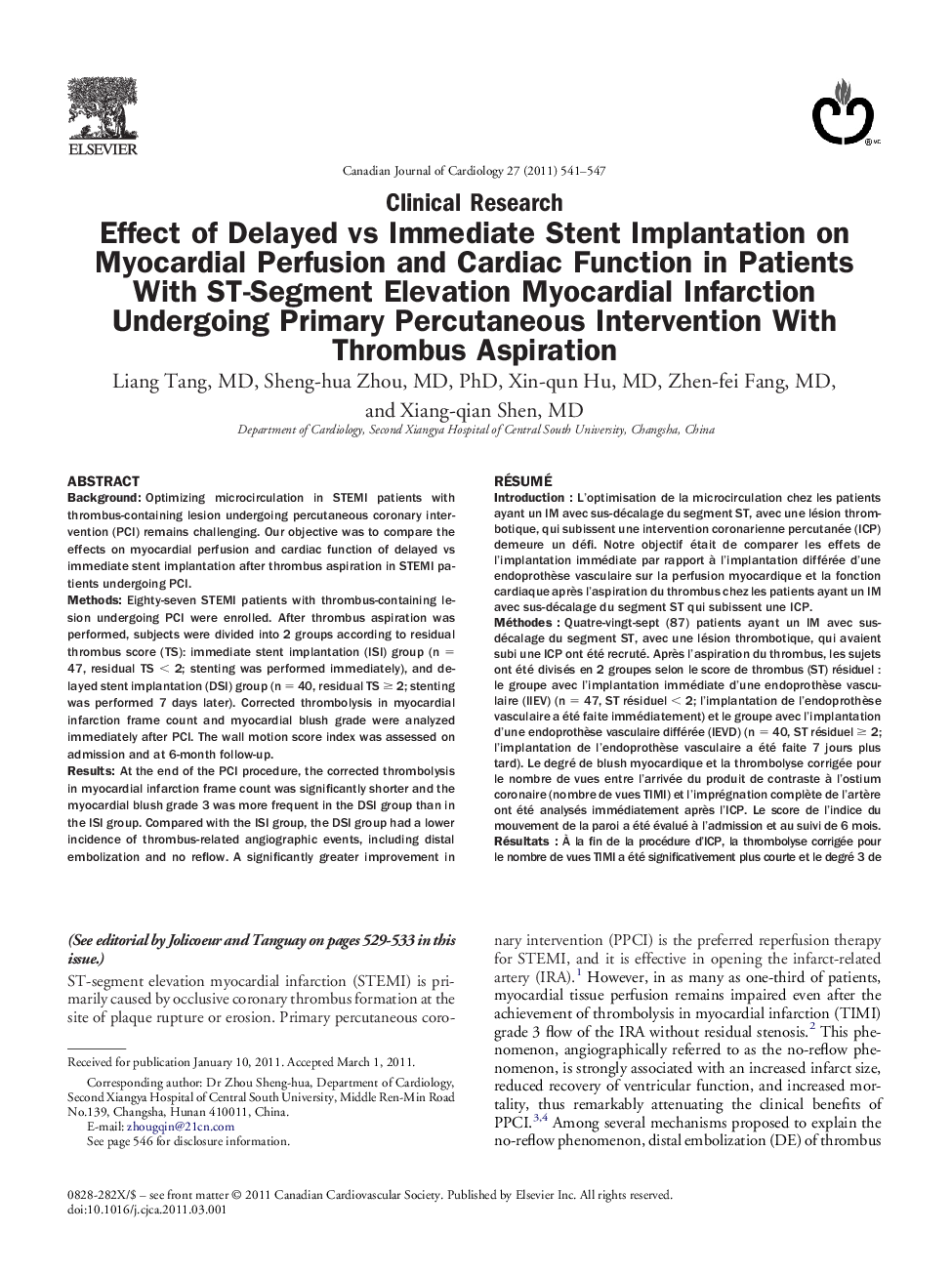| Article ID | Journal | Published Year | Pages | File Type |
|---|---|---|---|---|
| 2727485 | Canadian Journal of Cardiology | 2011 | 7 Pages |
BackgroundOptimizing microcirculation in STEMI patients with thrombus-containing lesion undergoing percutaneous coronary intervention (PCI) remains challenging. Our objective was to compare the effects on myocardial perfusion and cardiac function of delayed vs immediate stent implantation after thrombus aspiration in STEMI patients undergoing PCI.MethodsEighty-seven STEMI patients with thrombus-containing lesion undergoing PCI were enrolled. After thrombus aspiration was performed, subjects were divided into 2 groups according to residual thrombus score (TS): immediate stent implantation (ISI) group (n = 47, residual TS < 2; stenting was performed immediately), and delayed stent implantation (DSI) group (n = 40, residual TS ≥ 2; stenting was performed 7 days later). Corrected thrombolysis in myocardial infarction frame count and myocardial blush grade were analyzed immediately after PCI. The wall motion score index was assessed on admission and at 6-month follow-up.ResultsAt the end of the PCI procedure, the corrected thrombolysis in myocardial infarction frame count was significantly shorter and the myocardial blush grade 3 was more frequent in the DSI group than in the ISI group. Compared with the ISI group, the DSI group had a lower incidence of thrombus-related angiographic events, including distal embolization and no reflow. A significantly greater improvement in wall motion score index from baseline to 6-month follow-up was observed in the DSI group compared with the ISI group.ConclusionsIn STEMI patients presenting with thrombus containing lesion undergoing PCI, delayed stent implantation after thrombus aspiration leads to better myocardial perfusion and cardiac functional recovery in comparison with immediate stent implantation.
RésuméIntroductionL'optimisation de la microcirculation chez les patients ayant un IM avec sus-décalage du segment ST, avec une lésion thrombotique, qui subissent une intervention coronarienne percutanée (ICP) demeure un défi. Notre objectif était de comparer les effets de l'implantation immédiate par rapport à l'implantation différée d'une endoprothèse vasculaire sur la perfusion myocardique et la fonction cardiaque après l'aspiration du thrombus chez les patients ayant un IM avec sus-décalage du segment ST qui subissent une ICP.MéthodesQuatre-vingt-sept (87) patients ayant un IM avec sus-décalage du segment ST, avec une lésion thrombotique, qui avaient subi une ICP ont été recruté. Après l'aspiration du thrombus, les sujets ont été divisés en 2 groupes selon le score de thrombus (ST) résiduel : le groupe avec l'implantation immédiate d'une endoprothèse vasculaire (IIEV) (n = 47, ST résiduel < 2; l'implantation de l'endoprothèse vasculaire a été faite immédiatement) et le groupe avec l'implantation d'une endoprothèse vasculaire différée (IEVD) (n = 40, ST résiduel ≥ 2; l'implantation de l'endoprothèse vasculaire a été faite 7 jours plus tard). Le degré de blush myocardique et la thrombolyse corrigée pour le nombre de vues entre l'arrivée du produit de contraste à l'ostium coronaire (nombre de vues TIMI) et l'imprégnation complète de l'artère ont été analysés immédiatement après l'ICP. Le score de l'indice du mouvement de la paroi a été évalué à l'admission et au suivi de 6 mois.RésultatsÀ la fin de la procédure d'ICP, la thrombolyse corrigée pour le nombre de vues TIMI a été significativement plus courte et le degré 3 de blush myocardique a été plus fréquent dans le groupe d'IEVD que dans le groupe d'IIEV. Comparativement au groupe d'IIEV, le groupe d'IEVD a eu une incidence plus faible d'événements angiographiques liés au thrombus, incluant l'embolisation distale et la non-reperfusion. Une amélioration significativement plus grande dans le score de l'indice du mouvement de la paroi selon l'indice de base au suivi de 6 mois a été observée dans le groupe IEVD comparativement au groupe IIEV.ConclusionsChez les patients ayant un IM avec sus-décalage du segment ST présentant une lésion thrombotique qui ont subi une ICP, l'implantation d'une endoprothèse vasculaire après l'aspiration du thrombus mène à une meilleure perfusion myocardique et un rétablissement cardiaque fonctionnel comparativement à l'implantation immédiate d'une endoprothèse vasculaire.
